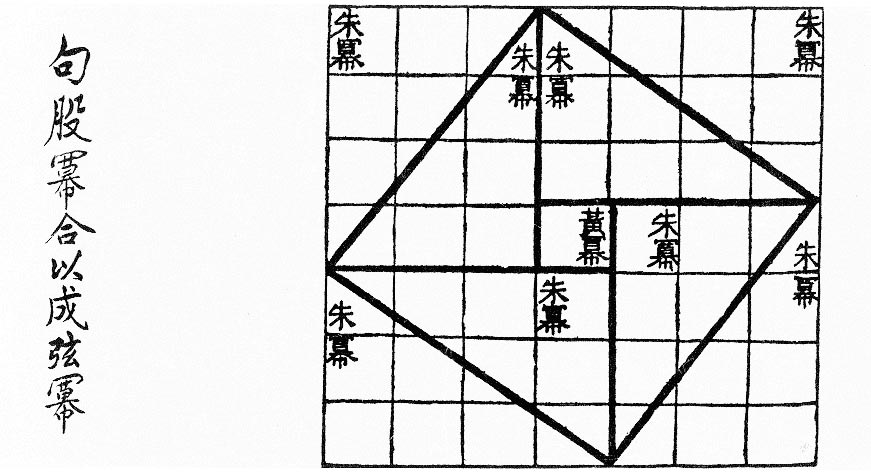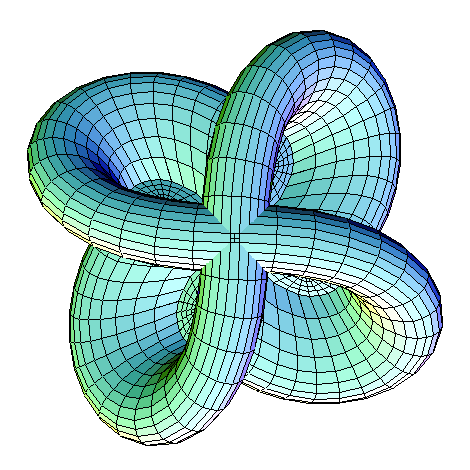Mathematical visualization on:
[Wikipedia]
[Google]
[Amazon]

 Geometry can be defined as the study of shapes their size, angles, dimensions and proportions
Geometry can be defined as the study of shapes their size, angles, dimensions and proportions



 Permutation groups have nice visualizations of their elements that assist in explaining their structure—e.g., the rotated and flipped regular p-gons that comprise the dihedral group of order 2p. They may be used to "see" the relationships among linking numbers between branch curves of dihedral covering spaces of knots and links.
Permutation groups have nice visualizations of their elements that assist in explaining their structure—e.g., the rotated and flipped regular p-gons that comprise the dihedral group of order 2p. They may be used to "see" the relationships among linking numbers between branch curves of dihedral covering spaces of knots and links.
 Stephen Wolfram's book on cellular automata, '' A New Kind of Science'' (2002), is one of the most intensely visual books published in the field of mathematics. It has been criticized for being ''too'' heavily visual, with much information conveyed by pictures that do not have formal meaning.
Stephen Wolfram's book on cellular automata, '' A New Kind of Science'' (2002), is one of the most intensely visual books published in the field of mathematics. It has been criticized for being ''too'' heavily visual, with much information conveyed by pictures that do not have formal meaning.

 * Proofs without words have existed since antiquity, as in the Pythagorean theorem proof found in the ''Zhoubi Suanjing'' Chinese text which dates from 1046 BC to 256 BC.
* The
* Proofs without words have existed since antiquity, as in the Pythagorean theorem proof found in the ''Zhoubi Suanjing'' Chinese text which dates from 1046 BC to 256 BC.
* The  *
* 
Virtual Math Museum
{{Computer science Geometry Visualization (graphics)

Mathematical
Mathematics is an area of knowledge that includes the topics of numbers, formulas and related structures, shapes and the spaces in which they are contained, and quantities and their changes. These topics are represented in modern mathematics ...
phenomena can be understood and explored via visualization
Visualization or visualisation may refer to:
* Visualization (graphics), the physical or imagining creation of images, diagrams, or animations to communicate a message
* Data visualization, the graphic representation of data
* Information visuali ...
. Classically this consisted of two-dimensional drawings or building three-dimensional models (particularly plaster models in the 19th and early 20th century), while today it most frequently consists of using computers to make static two or three dimensional drawings, animations, or interactive programs. Writing programs to visualize mathematics is an aspect of computational geometry
Computational geometry is a branch of computer science devoted to the study of algorithms which can be stated in terms of geometry. Some purely geometrical problems arise out of the study of computational geometric algorithms, and such problems ar ...
.
Applications
Mathematical visualization is used throughout mathematics, particularly in the fields ofgeometry
Geometry (; ) is, with arithmetic, one of the oldest branches of mathematics. It is concerned with properties of space such as the distance, shape, size, and relative position of figures. A mathematician who works in the field of geometry is c ...
and analysis
Analysis ( : analyses) is the process of breaking a complex topic or substance into smaller parts in order to gain a better understanding of it. The technique has been applied in the study of mathematics and logic since before Aristotle (3 ...
. Notable examples include plane curves, space curve
In mathematics, a curve (also called a curved line in older texts) is an object similar to a line, but that does not have to be straight.
Intuitively, a curve may be thought of as the trace left by a moving point. This is the definition that ...
s, polyhedra
In geometry, a polyhedron (plural polyhedra or polyhedrons; ) is a three-dimensional shape with flat polygonal faces, straight edges and sharp corners or vertices.
A convex polyhedron is the convex hull of finitely many points, not all on ...
, ordinary differential equation
In mathematics, an ordinary differential equation (ODE) is a differential equation whose unknown(s) consists of one (or more) function(s) of one variable and involves the derivatives of those functions. The term ''ordinary'' is used in contrast ...
s, partial differential equation
In mathematics, a partial differential equation (PDE) is an equation which imposes relations between the various partial derivatives of a multivariable function.
The function is often thought of as an "unknown" to be solved for, similarly to h ...
s (particularly numerical solutions, as in fluid dynamics
In physics and engineering, fluid dynamics is a subdiscipline of fluid mechanics that describes the flow of fluids— liquids and gases. It has several subdisciplines, including ''aerodynamics'' (the study of air and other gases in motion) a ...
or minimal surfaces such as soap film
Soap films are thin layers of liquid (usually water-based) surrounded by air. For example, if two soap bubbles come into contact, they merge and a thin film is created in between. Thus, foams are composed of a network of films connected by Platea ...
s), conformal map
In mathematics, a conformal map is a function that locally preserves angles, but not necessarily lengths.
More formally, let U and V be open subsets of \mathbb^n. A function f:U\to V is called conformal (or angle-preserving) at a point u_0\in ...
s, fractal
In mathematics, a fractal is a geometric shape containing detailed structure at arbitrarily small scales, usually having a fractal dimension strictly exceeding the topological dimension. Many fractals appear similar at various scales, as ill ...
s, and chaos.
Geometry
Linear algebra
Complex analysis
Incomplex analysis
Complex analysis, traditionally known as the theory of functions of a complex variable, is the branch of mathematical analysis that investigates Function (mathematics), functions of complex numbers. It is helpful in many branches of mathemati ...
, functions of the complex plane are inherently 4-dimensional, but there is no natural geometric projection into lower dimensional visual representations. Instead, colour vision is exploited to capture dimensional information using techniques such as domain coloring.
Chaos theory
Differential geometry

Topology
Many people have a vivid “mind’s eye,” but a team of British scientists has found that tens of millions of people cannot conjure images. The lack of a mental camera is known as aphantasia, and millions more experience extraordinarily strong mental imagery, called hyperphantasia. Researchers are studying how these two conditions arise through changes in the wiring of the brain. Visualization played an important role at the beginning of topological knot theory, when polyhedral decompositions were used to compute the homology of covering spaces of knots. Extending to 3 dimensions the physically impossible Riemann surfaces used to classify all closed orientable 2-manifolds, Heegaard's 1898 thesis "looked at" similar structures for functions of two complex variables, taking an imaginary 4-dimensional surface in Euclidian 6-space (corresponding to the function f=x^2-y^3) and projecting it stereographically (with multiplicities) onto the 3-sphere. In the 1920s Alexander and Briggs used this technique to compute the homology of cyclic branched covers of knots with 8 or fewer crossings, successfully distinguishing them all from each other (and the unknot). By 1932 Reidemeister extended this to 9 crossings, relying on linking numbers between branch curves of non-cyclic knot covers. The fact that these imaginary objects have no "real" existence does not stand in the way of their usefulness for proving knots distinct. It was the key to Perko's 1973 discovery of the duplicate knot type in Little's 1899 table of 10-crossing knots.Graph theory
 Permutation groups have nice visualizations of their elements that assist in explaining their structure—e.g., the rotated and flipped regular p-gons that comprise the dihedral group of order 2p. They may be used to "see" the relationships among linking numbers between branch curves of dihedral covering spaces of knots and links.
Permutation groups have nice visualizations of their elements that assist in explaining their structure—e.g., the rotated and flipped regular p-gons that comprise the dihedral group of order 2p. They may be used to "see" the relationships among linking numbers between branch curves of dihedral covering spaces of knots and links.
Combinatorics
Cellular automata
 Stephen Wolfram's book on cellular automata, '' A New Kind of Science'' (2002), is one of the most intensely visual books published in the field of mathematics. It has been criticized for being ''too'' heavily visual, with much information conveyed by pictures that do not have formal meaning.
Stephen Wolfram's book on cellular automata, '' A New Kind of Science'' (2002), is one of the most intensely visual books published in the field of mathematics. It has been criticized for being ''too'' heavily visual, with much information conveyed by pictures that do not have formal meaning.
Computation

Other examples
 * Proofs without words have existed since antiquity, as in the Pythagorean theorem proof found in the ''Zhoubi Suanjing'' Chinese text which dates from 1046 BC to 256 BC.
* The
* Proofs without words have existed since antiquity, as in the Pythagorean theorem proof found in the ''Zhoubi Suanjing'' Chinese text which dates from 1046 BC to 256 BC.
* The Clebsch diagonal surface
In mathematics, the Clebsch diagonal cubic surface, or Klein's icosahedral cubic surface, is a non-singular cubic surface, studied by and , all of whose 27 exceptional lines
can be defined over the real numbers. The term Klein's icosahedral surf ...
demonstrates the 27 lines on a cubic surface
In mathematics, a cubic surface is a surface in 3-dimensional space defined by one polynomial equation of degree 3. Cubic surfaces are fundamental examples in algebraic geometry. The theory is simplified by working in projective space rather than ...
.
Sphere eversion
In differential topology, sphere eversion is the process of turning a sphere inside out in a three-dimensional space (the word '' eversion'' means "turning inside out"). Remarkably, it is possible to smoothly and continuously turn a sphere in ...
– that a sphere can be turned inside out in 3 dimension if allowed to pass through itself, but without kinks – was a startling and counter-intuitive result, originally proven via abstract means, later demonstrated graphically, first in drawings, later in computer animation.
The cover of the journal ''The Notices of the American Mathematical Society
''Notices of the American Mathematical Society'' is the membership journal of the American Mathematical Society (AMS), published monthly except for the combined June/July issue. The first volume appeared in 1953. Each issue of the magazine sinc ...
'' regularly features a mathematical visualization.

See also
* Mathematical diagram *Geometry Center
The Geometry Center was a mathematics research and education center at the University of Minnesota. It was established by the National Science Foundation in the late 1980s and closed in 1998. The focus of the center's work was the use of comput ...
References
*External links
Virtual Math Museum
{{Computer science Geometry Visualization (graphics)